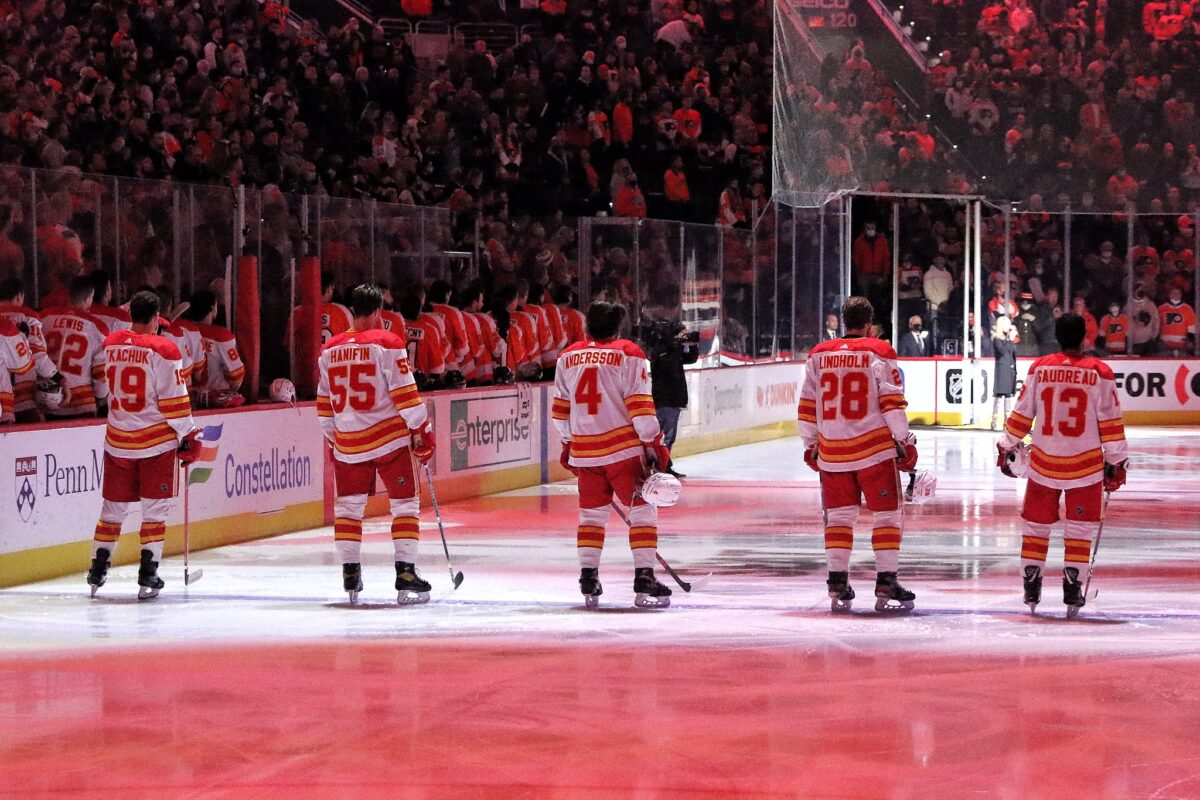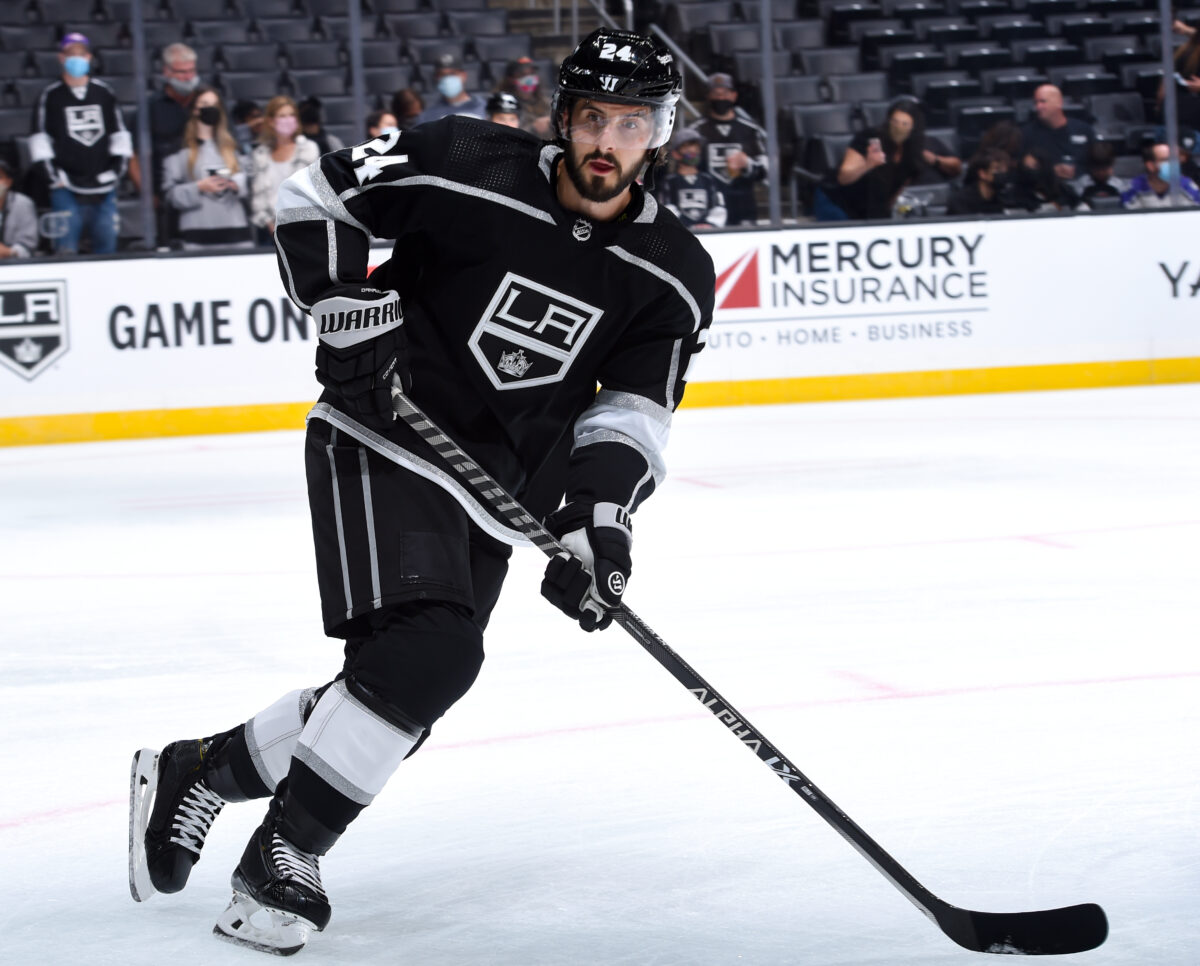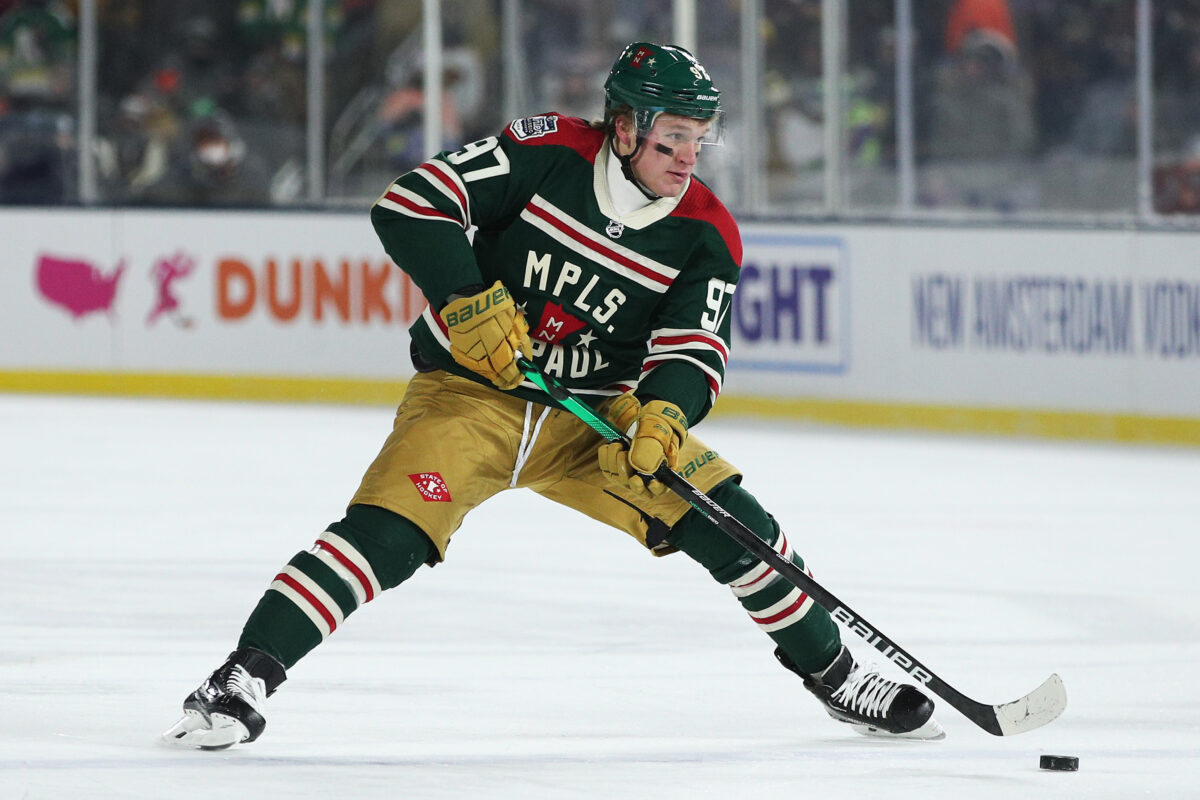Whether a team is an aspiring Stanley Cup contender or one of the NHL’s basement-dwellers, being able to trot out a dependable forward line night after night is a key to fostering sustained on-ice success. A frequently used trio often transforms into a physical manifestation of a team’s culture and values, and their ability to consistently drive play or goalscoring can be their guiding compass. The NHL recently passed the midpoint of the 2021-22 season, giving us a sizeable sample of data to work with to identify this year’s most dominant forward lines.
The only objective criteria I abided by is that a line must have played a minimum of 150 minutes together at even strength to qualify for this list. In instances where lines have posted similar results, I picked the trios that have played a greater amount of minutes together or have faced more difficult competition, as their numbers are less likely to be a product of variance.
However, dominance is subjective and is reflected in the listed lines. Certain groups have had tremendous success in controlling the majority of the total shots and scoring chances, while others have been prolific in their goalscoring. In some cases, unsustainable finishing (or goaltending) can make lines look stronger or weaker than they actually are, and I used my discretion in blending the different factors in my analysis. With that, let’s dig in.
Toronto Maple Leafs: Michael Bunting, Auston Matthews, and Mitch Marner
When free-agent winger Zach Hyman signed with the Edmonton Oilers this past offseason, much was made about how the Toronto Maple Leafs could replace his sizeable two-way impact and feverish forechecking. Local product Michael Bunting, formerly of the Arizona Coyotes, was tabbed as one of several new additions meant to collectively offset Hyman’s departure. He’s delivered much more than is expected of someone earning less than $1 million, and his seamless transition has given the Maple Leafs one of the NHL’s most dangerous forward triumvirates this season.
Related: Maple Leafs Passed on Klingberg Trade – NHL Insider
In tandem with Toronto’s established superstars in Auston Matthews and Mitch Marner, the team’s first line has overwhelmed their matchups to the tune of a 23-12 ledger in actual goals over 250 minutes of play. Their 5.43 goals per-60-minutes at 5v5 is the third-most prolific among qualified trios, and their 62.2% share of the total expected goals tally (xGF%) ranks sixth in the NHL. Although much of their value is derived from the offensive side of the puck, they haven’t neglected their defensive duties. Among the 61 qualified lines, the Bunting-Matthews-Marner line ranks 22nd in chance quality conceded (xGA/60) and seventh in their rate of shots allowed (CA/60).

Matthews and Marner have re-established their fearsome connection after a slow start for Marner in particular. The reigning Rocket Richard winner is once again firing at a near 60-goal pace this season (33 goals in 46 games), and Marner is producing at a 92-point clip. Bunting’s 33 points in 49 games (16 goals, 17 assists) has matched Hyman’s production (in five more games) for about $4.5 million less a season. The 25-year-old’s hard-nosed play and timely chippiness (his 27 drawn minor penalties rank second behind only Connor McDavid) pairs well with his linemates’ skill. According to tracking data collected by Corey Sznajder, Bunting is fifth among the team’s forward group in terms of scoring chances per-60, behind only Toronto’s heralded big four.
After a tame playoff showing by Matthews (five points in seven games) and Marner (four in seven, zero goals) against the upstart Montreal Canadiens last season, the pressure is on the stars to perform. If the Maple Leafs finally conquer their first-round demons, it’ll be because this line continues to fire on all cylinders in the postseason.
Boston Bruins: Brad Marchand, Patrice Bergeron, and David Pastrnak
In one of the season’s least surprising developments, the Boston Bruins’ “Perfection Line” composed of Brad Marchand, Patrice Bergeron, and David Pastrnak grades out as one of the league’s best at both ends. Their underlying numbers are unparalleled, and the trio assumes territorial dominance no matter who they are thrown out to counter.
They control 63.5% of xGF (fourth among qualified lines) and rank within the top 20 in both xGF/60 (18th) and xGA/60 (eighth). They also account for the second-highest proportion of all unblocked shot attempts (66.1% FF%) and are second and fourth in unblocked shot attempts taken (FF/60) and conceded per-60 (FA/60) minutes, respectively. Whether you prioritize quantity or quality, Boston’s trio can deliver on both counts. Marchand and Pastrnak both remain elite in creating chances in transition, and Bergeron is still among the Bruins’ best playmakers.

Yet, they haven’t been able to parlay their puck possession into actual goals to the same degree as in years past. After scoring 4.55 goals per-60 and 4.09 per-60 in the past two seasons, the trio is only converting 3.68 per-60 in 2021-22. Bergeron and Marchand have both observed a dip in their shooting percentages (SH%) compared to last season, and the Bruins’ captain is only firing at a 7.4% clip, a far cry from last year’s 12.6%. Father Time could finally be coming for this generation’s best two-way center, but I’d chalk up the future Hall of Famer’s poor finishing to plain old bad luck. For now.
Interestingly enough, the NHL’s best line by xGF% is Bergeron and Marchand flanked by Craig Smith (70.6%), and its impact is mainly derived from its league-best 1.42 xGA/60. Still, the Bruins preeminent trio have spent an additional 70 minutes together, giving them the edge in my eyes. Their dominance has yet to translate into tangible goals, but it’s only a matter of time until the pucks start hitting the back of the net. A pressing question needing to be answered ahead of the trade deadline is where the Bruins rank in the Eastern Conference hierarchy.
Calgary Flames: Matthew Tkachuk, Elias Lindholm, and Johnny Gaudreau
The maddeningly inconsistent Calgary Flames have often teetered on the edge of a rebuild in recent years. Still, their performance under the guidance of head coach Darryl Sutter places them firmly in Stanley Cup contention this season. Driving the Flames’ success is their potent first-line composed of the shifty Johnny Gaudreau, uber-pest Matthew Tkachuk, and reliable goal-scorer Elias Lindholm.
Related: Flames’ Gaudreau Emerging as a Top Candidate for the Hart Trophy
By every conceivable metric, Calgary’s primary forward triumvirate ranks at or near the top of the list. Over 600 cumulative minutes at 5v5, the trio has controlled 62.8% of xGF (fifth among qualified lines) and ranks within the top 15 in both xGF and xGA per-60. They’ve accounted for over 76% of actual goals (45 for and 14 against) while scoring the fifth-most goals per-60 this season (4.5/60). All three members are producing at a point-per-game pace at minimum, and Gaudreau (fifth) and Tkachuk (10th) sit within the top 10 of NHL scoring. Recently, trade rumors have swirled around whether the franchise might part ways with their flagship players, but their performances this season have quelled those conversations for the time being.

It’s easy to see why this trio works so well together, with each player’s strengths complementing the other’s skillsets. Gaudreau is a zone entry machine (third in completed zone entries per-60) with the ability to routinely dismantle even the sturdiest of defenses as his 4.4 high-danger passes per-60 is the highest rate in the league this season. Tkachuk is the team’s most successful forechecker in terms of recovered dump-ins, and both he and Lindholm can find open space to capitalize on Gaudreau’s unassailable vision with the puck.
With games in hand on a Vegas Golden Knights club currently without the services of Mark Stone, the Flames are in a favorable position heading into the postseason after tying their record for consecutive wins. They can stroll to the Pacific Division title and set up an easy first-round bout with one of a number of decent but inconsistent teams vying for a wildcard position. They’ll be in tough to unseat the rampaging Colorado Avalanche, but on the back of two powerful forward lines and a robust defensive system anchored by the impenetrable Jacob Markstrom, they might just do it.
Los Angeles Kings: Viktor Arvidsson, Phillip Danault, and Trevor Moore
Given Phillip Danault’s immense role in piloting the Montreal Canadiens to their first Stanley Cup Final appearance in nearly 30 years last season, it’s no surprise to see his influence carry over to his new role with the Los Angeles Kings. On a line flanked by two small but feisty wingers in Viktor Arvidsson and Trevor Moore, the steadily ascendant Kings own one of the strongest forward trios in the NHL, both in terms of driving play and capitalizing on their opportunities.
You May Also Like:
- Oilers’ Skinner in Line for Vezina Trophy Winning Season
- Colorado Avalanche Won’t Be Contenders This Season
- Oilers: 8 GMs Who Would’ve Been Better Hires Than Stan Bowman
- New York Rangers’ 4 Best Contracts for 2024-25
- 3 Winnipeg Jets Who Could Earn a Roster Spot in 2024-25
Among qualified lines, Los Angeles’ second-most used forward group ranks 11th in xGF% (61.7%), third in actual goal share (78.9%), and are first in both expected goals and shot attempts for per-60 at 5v5. Danault’s two-way presence combined with the speed and tenacity of both Arvidsson and Moore results in a pestering line capable of carving open defenses off of the rush or through a robust cycle game down low. Arvidsson leads the NHL in rush shots per-60, and Danault sits behind only Nick Cousins and Nikita Kucherov in forechecking/cycle shots per-60. Moore’s impact is not to be downplayed, where the waterbug winger generates the third-highest rate of zone entries in the league. The line has no issues with gaining the zone and is impossible to dislodge once they’ve set up their cycle offense.

Unsurprisingly, each of the line’s three members has experienced an offensive renaissance on an individual level. Danault has established a new career-high in goals (14), Moore in points (26), and Arvidsson has enjoyed his best offensive season since 2018-19 with 32 points in 43 games. Their increased production coupled with Jonathan Quick’s resurgence in goal (ninth in goals saved above expected this season) has given the Kings an outside chance at the playoffs. They currently occupy the final wild card spot in the Western Conference and figure to be in the thick of the conversation over the regular season’s final 30-odd games. Could they make a splash at the trade deadline?
Minnesota Wild: Kirill Kaprizov, Ryan Hartman, and Mats Zuccarello
How good is Kirill Kaprizov? He’s made the Minnesota Wild appointment viewing, and his line has toyed with opposing defenses all season long. The team’s .691 points percentage through 47 games puts them on track to shatter their previous franchise record of 106 points set in the 2016-17 season, and Kaprizov and his band of merry men are the faces of their new proclivity for offense. The Wild’s primary attacking unit ranks first in goals scored per-60-minutes (5.53 per-60) among qualified lines. They haven’t dominated the chance quality battle in a similar fashion (only 49.8% of expected goals) but have leaned on the disparity in skill to capitalize on the chances they do create.
Kaprizov was handed a monstrous five-year, $45 million contract extension after his enthralling rookie campaign in which he finished eight in goalscoring with 27 tallies. The corresponding $9 million annual average value (AAV) meant that all eyes were on the Russian to see whether he could live up to his price tag, and he’s blasted those expectations out of the water. He’s upped his offensive output by producing 1.35 points per game this season, which is fourth among qualified skaters and represents a 110-point pace over 82 games. Whatever qualms people had with the contract before the season have been thoroughly extinguished.

For only $1.7 million, Hartman has proven to be one of the league’s best bargains as a complimentary piece beside Kaprizov. The 27-year-old center has exceeded or tied career highs in every major offensive category, posting 36 points in 47 games (19 goals and 17 assists) this season. His 13.3% shooting percentage (SH%) is another career benchmark, but he’s not necessarily just the beneficiary of favorable puck luck. Hartman has been able to wriggle into dangerous areas of the ice on a consistent basis, as the 2.54 shots per game off of high-danger passes (those moving across the slot or from behind the net) that he’s firing leads the Wild and is among the highest rates in the league this season. Minnesota represents his fourth NHL team, but it appears he’s finally found a permanent home in the North Star State.
Not to be disregarded are the contributions of 34-year-old Mats Zuccarello, the diminutive winger whose enjoying the most productive campaign of his career. His total of 52 points in 41 games is already only nine points away from his career-best, and his playmaking talents (14th in primary assists) have been on full display this season. He is a menace in transition, second only to Kevin Fiala on the Wild in terms of controlled zone entries (with possession of the puck) leading to scoring chances. Minnesota looks like a real contender to challenge for the Western Conference crown, and this trio can claim much of the responsibility for the franchise’s excitement and renewed optimism.
NHL Is Full of Dynamic Forward Lines
Although I’ve included several honorable mentions below to go with the five other lines I highlighted in this article, there are sure to be some deserving candidates left out. Which forward trios not mentioned here have stood out to you this season? Let me know in the comments.
Honorable Mentions: Rickard Rakell, Trevor Zegras, and Sonny Milano, Anaheim Ducks; Andrew Mangiapane, Mikael Backlund, and Blake Coleman, Calgary Flames; Jason Robertson, Joe Pavelski, and Roope Hintz, Dallas Stars; Filip Forsberg, Matt Duchene, and Mikael Granlund, Nashville Predators; Andreas Johnsson, Dawson Mercer, and Jesper Bratt, New Jersey Devils
Data courtesy of All Three Zones, Hockey Reference, MoneyPuck, and Natural Stat Trick. Statistics are accurate as of February 22, 2021.